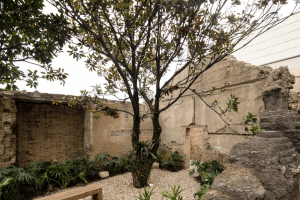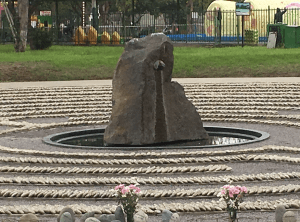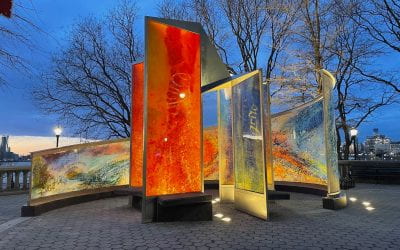Evolving Memory
The surest engagement with memory of atrocities throughout Latin America and the Caribbean may actually lie in its perpetual irresolution, that only an unfinished memorial process can guarantee the life of memory. For it may be the finished monument that completes memory itself, puts a cap on memory-work and draws a bottom line underneath an era that will forever haunt. As is the case with Germany, the same could be said for any of the Southern Cone dictatorships, the horrors and disappearances of the civil conflicts in Latin America, and, indeed, the victims of violence throughout Latin America and the Caribbean.
I’ve had an ongoing, lifelong conversation about memory, art and loss with my family, with the artists and architects whose works move and inspire me, and with the friends and colleagues whoshare my preoccupation with memorials and museums. Much of this has centered on Germany, although I’ve done consulting on memorials with the Argentine government.
In Latin America, as in Europe and elsewhere, the monument reflects both its socio-historical and aesthetic contexts: artists working in eras of cubism, expressionism, socialist realism, earthworks, minimalism or conceptual art remain answerable to both the needs of art and official history. In Latin America, the result has been a slow metamorphosis of the monument from the heroic, self-aggrandizing figurative icons of the late 19th century celebrating national ideals and triumphs to the anti-heroic, often ironic and self-effacing conceptual installations marking the national ambivalence and uncertainty of late 20th century post-modernism.

Fragmentos by Doris Salcedo. Photo courtesy of Andreas Huyssen.
The possibility that art might redeem mass murder with beauty (or with ugliness), or that memorials might somehow redeem this past with the instrumentalization of its memory, continues to haunt a post-conflict generation of memory-artists such as Doris Salcedo and Marcelo Brodsky, among others.
One of the most compelling results of Latin America’s memorial conundrum has been the slow advent of its “counter-monuments”—brazen, painfully self-conscious memorial spaces conceived to challenge the very premises of their being. At home in an era of earthworks, conceptual and self-destructive art, a post-conflict generation of artists from Argentina to Peru to Colombia now explore both the necessity of memory and their incapacity to recall events some of them never experienced directly.
Instead of searing memory into public consciousness, they fear, conventional memorials seal memory off from awareness altogether; instead of embodying memory, they find that memorials may only displace memory. These artists fear rightly that to the extent that we encourage monuments to do our memory-work for us, we become that much more forgetful. They believe, in effect, that the initial impulse to memorialize events like civil wars, dictatorships and disappearances may actually spring from an opposite and equal desire to forget them.
I’ve long believed that the best way to save the monument, if it’s worth saving at all, is to enlarge its life and texture to include its genesis in historical time, the activity that brings a monument into being, the debates surrounding its origins, its production, its reception, its life in the mind.
At one point in her description of how her design for the Vietnam Veterans’ Memorial would work, Maya Lin suggested that the difference between a “monument” and a “memorial” was that the monument was fixed, whereas a memorial allowed for movement into and out of its space. As Maya Lin described it in her original proposal, “The memorial is composed not as an unchanging monument, but as a moving composition, to be understood as we move into and out of it.”[i] That is, as a “monument” is fixed and static, her memorial would be defined by our movement through its space, memory by means of perambulation and walking through. In Latin America, the shift has begun from the grandiose and ubiquitous monumental statues of Bolívar to the subtle and ever-shifting memorial sites such as Lima’s El Ojo que Llora (The Eye that Weeps).

El Ojo Que Llora. Photo courtesy of Margarita Saona.
In post-9/11 New York, our memorial questions were very different: how to commemorate and articulate the loss of nearly three thousand lives at the hands of terrorists and, at the same time, how to create a memorial site for ongoing life and regeneration? By necessity, the National 9/11 Memorial and Museum would have to do both. This is why we chose a design that had the capacity for both remembrance and reconstruction, space both for memory of past destructionand for present life and its regeneration. It had to be an integrative design, a complex that would mesh memory with life, embed memory in life, and balanceour need for memory with the present needs of the living. It could not be allowed to disable life or take its place, but rather inspire life, regenerate it, and provide for it. It would have to be a design that animates and reinvigorates this site, but does not paralyze it, with memory. In the same fashion, memorials in Latin America integrate memory with the present needs of the living because they are dealing with crisis and regeneration at the same time they are commemorating past conflicts.
Underlying all of these national memorial projects, the question remains: What do monuments and memory have to do with each other? “Every period has the impulse to create symbols in the form of monuments,” the theorist Sigmund Giedion has written, “which according to the Latin meaning are ‘things that remind,’ things to be transmitted to later generations. This demand for monumentality cannot, in the long run, be suppressed. It will find an outlet at all costs.” This may still be true, I believe, which leads me to ask just what these outlets and their costs are today. Indeed, the forms this demand for the monumental now takes, and to what self-abnegating ends, throw the presumptive link between monuments and memory into fascinating relief. The need for a unified vision of the past as found in the traditional monument necessarily collides with the modern conviction that neither the past nor its meanings are ever just one thing.

Liberty Doll transformed from a confiscated Statue of Liberty in Colombia. Credit: Marcela Fernanda Pardo García
But in an increasingly democratic age (despite its setbacks), in which the stories of nations are being told in the multiple voices of its everyday historians—that is, its individual citizens—monolithic meaning and national narratives are as difficult to pin down as they may be nostalgically longed for. The result has been a shift away from the notion of a national “collective memory” to what I would call a nation’s “collected memory.” Here we recognize that we never really shared each other’s actual memory of past or even recent events, but that in sharing common spaces in which we collect our disparate and competing memories, we find common (perhaps even a national) understanding of widely disparate experiences and our very reasons for recalling them.
This relatively newfound sense of public ownership of national memory, that this memory may actually be ours somehow and not on vicarious loan to us for the sake of common identity, has been embraced by a new generation of memorial makers who also harbor a deep distrust for traditionally static forms of the monument, which in their eyes have been wholly discredited by their consort with the last century’s most egregiously dictatorial regimes.
Spring/Summer 2021, Volume XX, Number 3
James E. Young is Distinguished Professor Emeritus and Founding Director of the Institute for Holocaust, Genocide, and Memory Studies at the University of Massachusetts Amherst. He was a juror for both the Denkmal and 9/11 Memorial design competitions. This essay has been adapted from the introduction to his book The Stages of Memory (2016).
Related Articles
My cry into the world
English + Español
It was September 20, 2019. “One hundred, two hundred, three hundred, four hundred….” That was how we felt and that was how we counted in the face of the irremediable absences provoked…
When Decolonization Meets an Immovable Monument
It was early October 2013, well before the present wave of toppling statues in the name of decolonization gained momentum in the United States and the United Kingdom…
The Ghosts of Canudos: A War Memorial
English + Español
Just like in the Argentine pampas or in the plains of Venezuela, the space in the Brazilian sertão, in the country’s Northeast region, has no limits. The hard brown land seems to stretch out in all directions, undulating endlessly, and the feeling it provokes is inevitably one of melancholy




